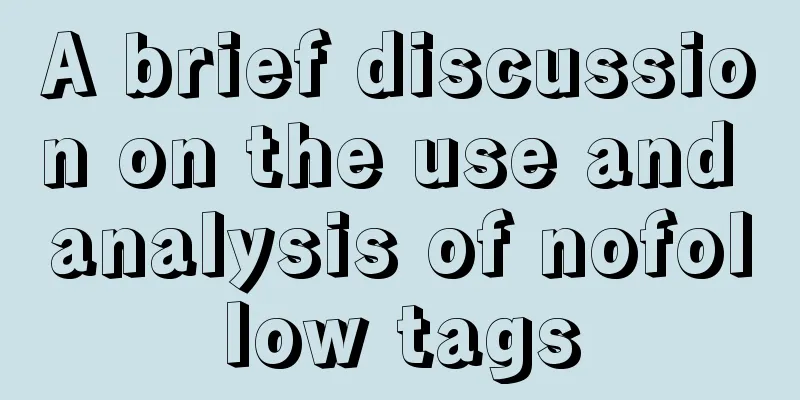A brief discussion on the use and analysis of nofollow tags

|
Controversy over nofollow There was a dispute between Zac and Guoping about nofollow for a while, that is, whether nofollow would waste PR. According to the explanation given by Google officials, suppose there are 10 links on a page. Then the PR of the page will be divided into 10 parts and distributed to these links. If one of the links is nofollow, the corresponding PR will not be exported. As for where the PR that should be directed to this link goes, it is unknown. Because according to the explanation, the PR that should be given to the nofollowed link is not given to other links that are not nofollowed. The controversy arises because of different interpretations of the original article. How does Baidu support nofollow? The above dispute is only directed at Google, and Baidu does not necessarily handle it in the same way as Google. In July 2010, Baidu search engineer LEE responded in the "Baidu Webmaster Club" that Baidu supports nofollow, but did not explain how to support nofollow, and whether the weight allocated to the links that are nofollowed is also wasted like Google. If it is really a waste, then it is best not to use the internal links. Why waste the weight of your own internal links? At the "Baidu Webmaster Platform - High-end SEO Club" salon on the evening of October 26, 2012, the author asked LEE in person about Baidu's support for nofollow. LEE means that the weight that should be given to the nofollowed link will be distributed to other links that are not nofollowed. So now using nofollow for internal links may be a waste of PR on Google, but on Baidu you can plan the flow of internal link weight. How to use nofollow There are two ways to use nofollow. One is to add the nofollow attribute to the link: a href=”URL” rel=”nofollow” flooding a href=”URL” rel=”external nofollow” flooding The first is a general way of writing, which is intended to tell search engines not to follow this link; the second is a more professional way of writing, which is intended to tell search engines that this is an external link and not to follow it. Both of these writing methods are for specific links, which can avoid exporting weight to these links and direct the remaining weight to other links on the page. After adding nofollow to a link, when the search engine first discovers this link, it will still put it in the queue of URLs to be crawled and it will be crawled, but the search engine will record the attribute description of it on the current web page, and the current page will not export weight to this link. Another way is that nofollow can also be used in meta tags: Both of these writing methods tell all search engines not to follow the links on this web page and not to pass weight to the links on the page. However, the first one is valid for all search engines, and the second one is only valid for Baidu. You can also replace it with the Spider name of other search engines. If the search engine supports this tag, it will have the same effect. If a page uses this tag, search engines will not be able to find and crawl the links on that page. Use nofollow to optimize internal links First of all, you can use nofollow links, which are links to pages that do not compete for rankings, such as registration, login, complaint, and report links. These links do not play a role in competing for rankings, they are just functional pages within the site, and all links to them within the entire site can be nofollowed. As for the commonly mentioned "Contact Us", it depends on the situation. Some websites have brands, and "***Contact Us" also has a high search volume. At this time, this page may have ranking value, and it is best not to nofollow its link. There should only be one outbound link from another page to another page. If it appears multiple times, you can start using the nofollow tag when it appears for the second time. In addition to the pages that do not compete for rankings mentioned above, nofollow can also be used to control the direction of site weight for web pages that compete for rankings. Tuniu.com’s homepage uses nofollow for internal links. The links in the dotted boxes are all nfollow links. Tuniu.com directs the weight of its homepage to pages that compete for rankings, such as travel destinations and regional guides, and nofollows all links to tour group information, probably because it considers that few people search for tour groups. Some friends may be wondering, since these contents are not given weight, can't we directly use the JS or framework calls introduced earlier? It can also reduce the size of the web page. It should be noted that Tuniu.com only does not give weight to these travel group information on its homepage. After using nofollow, Baidu can still find and crawl the pages pointed to by such links. If the content is good, it will still be indexed. Tuniu.com’s consideration should be to direct the weight of the homepage as much as possible to the pages of important competitive rankings, and not give more weight to the tour group information. However, this information still needs to be included in Baidu, and this tour group information can also enrich the content of the website’s homepage, unlike the noise links around the article pages. Therefore, nofollow is used directly on the link, and no JS or framework calling method is adopted. It should be noted here that even if nofollow is used for a link, search engines will still crawl and index it. This tag only suggests that the search engine should not pass weight to the link page on the current page, and it cannot prohibit search engines from crawling and indexing it. At the same time, nofollow is just a "suggestion" regarding weight. Search engines do not necessarily fully comply with the webmaster's settings. Instead, they have a relatively complete algorithm to determine whether various links are meaningful. Whether a specific link still carries weight will be calculated based on whether the link has recommendation significance. Search engines will refer to whether a link has nofollow, but they will not only refer to whether a link has a nofollow tag to determine whether the link will export weight. Search engines will not give webmasters complete authority over whether a link exports weight, otherwise chaos will occur. Continue with the use of nofollow above. This operation can be done not only on the homepage of the website, but also on any page of the website. Nofollow can assist webmasters and SEO personnel to better guide the flow of weight within the website, so that webmasters and SEO personnel can better optimize the internal link structure of the website. Many large websites now use nofollow. The external links exported from the Baidu Experience content page and the links to other Baidu products in the top navigation of Baidu Knows all use nofollow. Therefore, webmasters and SEOs should also pay attention to this tag. |
<<: MySQL database architecture details
>>: Implementation example of Nginx+Tomcat load balancing cluster
Recommend
JavaScript implements password box input verification
Sometimes it is necessary to perform simple verif...
CSS3 to achieve floating cloud animation
Operation effect html <head> <meta chars...
Vuex modularization and namespaced example demonstration
1. Purpose: Make the code easier to maintain and ...
Detailed steps for Spring Boot packaging and uploading to Docker repository
Important note: Before studying this article, you...
Tutorial on installing Odoo14 from source code on Ubuntu 18.04
Table of contents Background of this series Overv...
Example of how to implement MySQL cascading replication
The so-called cascading replication is that the m...
The difference and usage between div and span
Table of contents 1. Differences and characterist...
Introduction and analysis of three Binlog formats in MySQL
one. Mysql Binlog format introduction Mysql binlo...
JavaScript implements random generation of verification code and verification
This article shares the specific code of JavaScri...
Detailed example of locating and optimizing slow query sql in MySQL
Table of contents 1. How to locate and optimize s...
JS implements the curriculum timetable applet (imitating the super curriculum timetable) and adds a custom background function
Overview: I drew lessons from several timetable s...
JavaScript design pattern chain of responsibility pattern
Table of contents Overview Code Implementation Pa...
How to Develop a Progressive Web App (PWA)
Table of contents Overview Require URL of the app...
MySQL fuzzy query statement collection
SQL fuzzy query statement The general fuzzy state...
Five things a good user experience designer should do well (picture and text)
This article is translated from the blog Usability...









